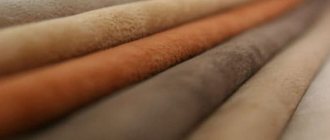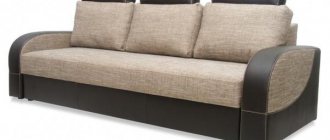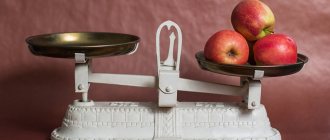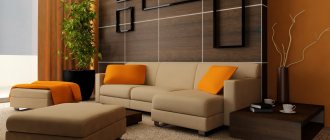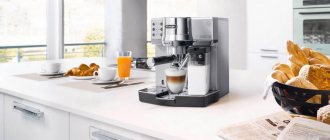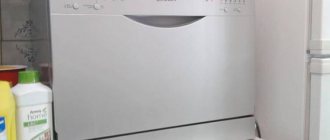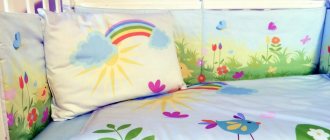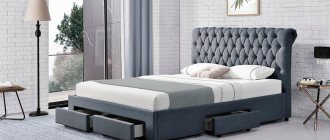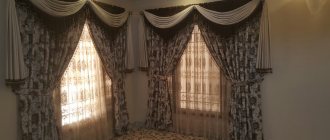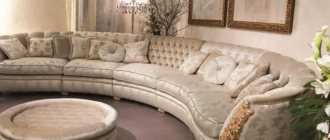Chenille is a dense, wear-resistant material with a pleasant velvety structure. This fabric has excellent consumer characteristics: it makes durable upholstery for furniture, high-quality curtains and drapes.
This fabric began to be woven in the USA about 200 years ago. Due to the special structure of the thread, it received the name “chenille”, which is translated from French as “caterpillar”. Indeed, chenille thread, braided with fluffy fibers for strength, resembles this insect.
Fabric characteristics
Composition and production technology
Chenille thread is made in a special way: combed fluffy fibers are woven into the main smooth thread, after which the workpiece is tightly twisted, forming a thread with a dense fleecy structure. This thread is called chenille.
After twisting, the threads are dyed and sent to the weaving factory. There they are made into fabric by weaving chenille fibers into the warp threads. And the greater the number of chenille threads woven into the fabric, the denser and heavier the material will be.
In the production of chenille, both natural (cotton) and synthetic (polyester, acrylic, artificial viscose) materials are used, making the fabric durable and strong.
Properties
The weave of threads in chenille fabric can be different: satin, tapestry, twill or jacquard. The structure, appearance and consumer characteristics of the material depend on weaving. The most valuable is chenille fabric with jacquard weave.
Properties of chenille:
- does not shrink after treatment with water, but can become deformed when exposed to high temperatures;
- It is elastic, does not stretch well, does not wrinkle;
- draped in heavy, large folds;
- paints well and has a rich palette of shades, thanks to which it is very popular among designers;
- The color lasts a long time, does not rub off or fade.
Furniture with chenille upholstery looks expensive and noble. Due to the fact that multi-colored threads can be used in the manufacture of canvas, furniture covered with this material shimmers in different shades.
Where to put furniture with microvelor upholstery
Since the fabric absorbs odors and cannot be washed, the best place for furniture with micro-velor upholstery would be the living room or bedroom.
For the living room, you can choose any color you like and thus complement the interior with bright colors. For a bedroom, the choice will be successful, since usually no one else sits on the furniture except the owners themselves. It will last longer.
It is better to purchase leather furniture for the hallway, since it is easier to remove dirt from it. In the kitchen and dining room there is a high risk of staining the upholstery with food.
Modern sofas with microvelor upholstery come in the following types:
- Straight - a classic, standard rectangular sofa.
- Corner - fits comfortably into a small room, can be folded out and used as an extra bed.
- Island units are an ideal option for spacious rooms; they can be placed in the center of the room.
You might be interested in this: The best options for beautifully hanging tulle on windows
A popular type of finishing is carriage screed. Furniture upholstery is stitched with buttons to create a diamond-shaped pattern, reminiscent of the upholstery in a royal carriage.
Island sofa
Types of chenille
According to its composition, chenille is divided into 3 types:
- Natural. The material contains more than 60% natural cotton fiber. It is environmentally friendly, hypoallergenic, pleasant to the touch and does not electrify. Its disadvantage is low strength.
- Artificial. The fabric is made from synthetic threads, cotton and artificial viscose. This chenille is stronger and more durable than natural, it is softer and more practical.
- Synthetic. The composition of the fabric is dominated by synthetic fibers - acrylic and polyester (more than 60%). The fabric is not very pleasant to the touch, but is durable and resistant to stains.
How to take care of fabric?
If you take care of microvelor, it will serve well for many years. Please note that the fabric cannot be washed as it may become damaged. Micro velor with Teflon upholstery requires regular cleaning with a vacuum cleaner.
Remove food stains, toothpaste, etc. with a wet napkin. You can also wash with soapy water or soda. You need to clean it carefully, do not pour a lot of water, otherwise the fabric will lose its appearance.
Areas of use
Chenille fabric is used in three areas:
- Furniture manufacturing. Durable fabric with a high content of fleecy threads is used for upholstery of upholstered furniture: sofas, armchairs and chairs. Products upholstered in chenille retain their beautiful appearance for a long time, do not fade or fade.
- Sewing home textiles. Curtains are made from less dense curtain chenille. Such products do not allow light to pass through, so they are often used to decorate a living room or bedroom. Often this fabric is used for blankets and bedspreads.
- Interior decor. Decorative panels are made from chenille and walls are covered with it. This material perfectly absorbs noise, does not accumulate dust and is easy to clean.
The note! When sewing clothes, chenille is rarely used due to the high density and heaviness of the products. Sometimes robes or aprons are made from it.
Comparison of chenille with other upholstery fabrics
The range of upholstery fabrics is huge, unfortunately, it is not limited to one type. Only furniture chenille has several varieties. It’s easy to get confused in the store; the annoying question “which is better” immediately arises:
- Chenille or matting? Chenille or velor? Chenille or flock? Tapestry or chenille?
This table will help you understand the difference between these fabrics.
| Fabric name | chenille | matting | velours |
| Fabric properties | |||
| Description | Soft, dense, fleecy fabric consisting of chenille threads | Rough but soft fabric with a fleecy surface and a silky sheen | Elegant, dense fabric with thick, velvety pile |
| Blade type | Woven, fabric-adhesive | Woven | Woven |
| Compound | Cotton, artificial fibers | Natural: cotton, linen, wool, silk; mixed: natural threads with synthetic fibers (polyester, acrylic) | Natural: cotton, linen, silk; mixed: natural threads with synthetic fibers |
| Colors | Plainly dyed, plain ornament or pattern, printed, woven pattern/subject | Plain dyed, melange, printed | Plain dyed, printed, woven pattern/subject |
| Peculiarities | Soft, elastic, wear-resistant, environmentally friendly, hypoallergenic | Rough, soft, wear-resistant, environmentally friendly, hypoallergenic | Soft, wear-resistant, environmentally friendly, hypoallergenic |
| Cleaning | Dry cleaning, dry cleaning | Wet cleaning: in a washing machine (delicate mode, temperature 30 degrees) without using chlorine-containing products; dry cleaning | Hand and machine wash (delicate mode, temperature 30 degrees) without the use of active chlorine-containing products; dry cleaning |
| Ironing | No ironing | Does not require ironing, but if necessary, can be ironed with a low-heat iron from the reverse side | Does not need ironing |
| Drying | Moisture should be avoided | Away from direct sunlight, no spin | Away from direct sunlight, no spin |
| Where is it used? | Furniture upholstery, wall upholstery, curtains, bedspreads | Furniture upholstery, upholstery of interior pillows, sewing curtains, bags, clothes | Furniture upholstery, upholstery of interior pillows, sewing of bedspreads, curtains, bags, clothes |
| Price | 500-8,000 rubles | 250-4,000 rubles | 300-1,500 rubles |
| Fabric name | flock | tapestry |
| Fabric properties | ||
| Description | Thick fabric with velvety pile | Thick fabric with a woven pattern |
| Blade type | Non-woven | Woven |
| Compound | Natural (cotton, wool), artificial (polyamide, polyester, viscose, acrylic, acetate, polypropylene), mixed | Natural: cotton, linen, silk; mixed: natural threads with synthetic fibers |
| Colors | Plain painted, colored | Woven pattern |
| Peculiarities | Soft, wear-resistant, does not absorb moisture | Dense, soft, lightweight, wear-resistant, environmentally friendly, hypoallergenic |
| Cleaning | Hand and machine wash (delicate mode, temperature 30 degrees) without the use of active chlorine-containing products; dry cleaning | Hand and machine wash (delicate mode, temperature 30 degrees) without the use of active chlorine-containing products; dry cleaning |
| Ironing | Does not require ironing, but if necessary, can be ironed with a low-heat iron from the reverse side | Does not require ironing, but if necessary, can be ironed with a low-heat iron from the reverse side |
| Drying | Away from direct sunlight, no spin | Away from direct sunlight, in a horizontal position, without spinning |
| Where is it used? | Furniture upholstery, upholstery of interior pillows, sewing curtains, clothes, toys | Upholstery of furniture, covering of interior pillows, creation of paintings, sewing of bedspreads, curtains, bags, clothes |
| Price | 150-2,000 rubles | 200-5,000 rubles |
Advantages and disadvantages
Advantages of the material:
- natural chenille is environmentally friendly and hypoallergenic;
- paints well, does not lose color over time, does not fade or rub off;
- has a pleasant velvety structure, reminiscent of corduroy to the touch;
- synthetic fabric is durable, wear-resistant, practical;
- It is cheaper than popular upholstery materials (for example, velor), but is not inferior to them in beauty.
Minuses:
- natural fabric absorbs water well, so it gets dirty easily;
- requires dry cleaning without the use of aggressive cleaning agents;
- the fabric is prone to snags: threads are easily pulled out when exposed to sharp objects.
Advice! If you have pets, you should not buy furniture with chenille upholstery. Sharp claws of pets will quickly ruin the canvas.
Chenille fabric for a sofa: pros and cons
Increasingly, for sofa upholstery, buyers choose a pleasant fabric similar to velor or corduroy, chenille, which appeared more than 200 years ago in the USA. The origins of the original fluffy threads come from Europe, and the name itself has French roots (chenille French - caterpillar). The really fluffy fibers wrapped around the base resemble a caterpillar. Today, the choice of practical upholstery fabric, called chenille, is quite wide and in demand. Its popularity is easily explained by its practicality, aesthetic properties and reasonable price.
Care
Chenille products require special care:
- stained fabric requires careful dry cleaning or professional dry cleaning;
- It is not recommended to wash fabric or remove dirt from it with aggressive detergents: it is better to use a vacuum cleaner or brush;
- to remove the stain, you can use a stain remover for upholstery fabrics;
- It is not advisable to place chenille products near hot radiators or heating devices, as the fabric may become deformed;
- It is not recommended to iron the material.
Advice! Newly appeared stains on the surface of the fabric can be removed with a small amount of soapy water. You need to mix liquid soap with water in a 1:1 ratio, apply this composition with a brush to the fabric, and after drying, vacuum it.
How to clean a velor sofa at home?
If stains from food and drinks, as well as other origins, appear on upholstered velor furniture, wet clean the surface. In doing so, observe the following rules:
- Start cleaning immediately after a stain appears; the longer it remains on the surface, the more difficult it will be to wash;
- Do not rub the surface under any circumstances, as you risk damaging the pile;
- your movements should be careful in the direction of the pile;
- do not use aggressive chemicals, acids and alkalis, or hard brushes for cleaning;
- as a detergent, use a solution of laundry soap and water, moistening a sponge or soft rag with the product;
- You can remove stubborn stains using a solution of alcohol and water; you can also apply a mixture of salt and soda to the stain, leaving the product on the surface for 2-3 hours.
Velor is a velvety material used as upholstery for upholstered furniture.
The material attracts with its amazing softness and chic appearance. A velor sofa will add comfort and sophistication to the room. The material does not lose its qualities over a long period of time and requires simple but regular maintenance. Did you like the article? Was she helpful?
Table 1: Best upholstery for sofas
| Upholstery type | Description | Nomination |
| Flock | Furniture fabric with velvet surface | Optimal price/quality ratio. Universal material |
| Chenille | Soft, slightly fluffy upholstery fabric | The best upholstery for children's furniture |
| Jacquard | Durable, rigid upholstery fabric with complex patterned weaves | The best upholstery for sophisticated interiors |
| Velours | Knitted upholstery fabric with pile | The best upholstery for furniture with a cover |
| Tapestry | Durable upholstery material with a wide variety of patterns | The best upholstery for country style living rooms |
| Leather | Natural upholstery material | The best upholstery for luxury furniture, for business interiors |
| Artificial leather (leatherette) | Substitute for genuine leather | The best upholstery for kitchen sofas, office and children's furniture |
The best universal upholstery for sofas is flock
Furniture flock
Sofa, upholstery - flock
Flock is the most common material for upholstering sofas. You will find furniture with flock in different price categories (both budget and luxury options).
Flock is produced by applying nylon pile to a base under the influence of an electrostatic field (this process is called flocking). Base composition: cotton and polyester. Flock imitates other upholstery materials - in appearance it can look like velor, suede, or chenille. This effect is achieved through the use of different piles. Flock is difficult to tear, so it is almost not afraid of cat claws . Stains are easily removed with soap and water. Flock is often treated with protective impregnations.
When cleaning a flock sofa, you should not use alcohol or strong solvents (the surface will become bald).
A sofa with flock upholstery is well suited for almost any situation - for families with small children, for a home with animals, for living rooms, children's rooms, bedrooms, dining rooms. Suitable even for furniture that will stand on a loggia or veranda (it will not “stiffen” when cooled). Flock is not suitable except for kitchen sofas and rooms where people smoke (it easily absorbs odors). If you have a choice, it is better not to take flock for transformable furniture (it is wiped off at the joints of parts).
From reviews of sofas with flock upholstery:
“When I needed a sofa, they advised me to take it from flock. Now he is over 3 years old. What are the conclusions? No need for bedding or capes, abrasion resistant. The cat really doesn’t bother him (tried it, didn’t like it, stopped). But I don’t recommend taking pillows from flock, it’s a bit harsh.”
Advantages of flock:
- lasting;
- waterproof;
- pleasant to the touch;
- easy to clean, does not get greasy;
- difficult to tear, does not cling;
- resistant to temperature changes;
- dust and wool stick little;
- large palette of colors and patterns
Disadvantages of flock:
- absorbs odors;
- the surface wears off over time.
The best upholstery for children's furniture is chenille
Furniture chenille
Sofa, upholstery - chenille
Chenille is a very practical upholstery. It feels like corduroy, but softer and more pleasant to the touch. Often used for children's furniture. Not suitable for pet owners.
From reviews of sofas upholstered in chenille:
“Our little daughter doesn’t care. She managed to draw on the new sofa with a green felt-tip pen. Of course, I was very upset. But I wiped it with regular dishwashing detergent and was pleasantly surprised - everything washed off without a trace. Conclusion: the quality of the upholstery material is good.”
Pros of chenille:
- lasting;
- wear-resistant;
- pleasant to the touch;
- does not cause allergies;
- does not absorb odors;
- the color is well preserved and fades little;
- not subject to deformation, does not stretch.
Cons of chenille:
- high price;
- absorbs moisture;
- Cat claw marks will be clearly visible.
The best upholstery for sophisticated interiors is jacquard
Furniture jacquard
Sofa, upholstery - jacquard
Very dense (even stiff) upholstery fabric with a wide variety of patterns. It does not fade in the sun, is wear-resistant, lasts a long time, so it is ideal for a sofa in the living room. Absolutely not suitable for a house where there is a cat (claws will leave puffs).
From reviews of sofas upholstered in jacquard:
“We spent a long time choosing a sofa. I wanted classics, jacquard upholstery and good quality. And then we found the Ashley Isabel Silver Leaf sofa. The color and pattern of the upholstery completely matched the photo on the website. The quality of the upholstery material is also beyond praise. The fabric is jacquard polyester, very dense, does not leave any snags or any other troubles. All pillows have zippers and, if desired, the pillowcases are easy to wash.”
Advantages of jacquard:
- strength;
- rigidity;
- wear resistance;
- resistance to sunlight (does not fade);
- long service life;
- pleasant to the touch;
- a wide range of patterns and colors;
Disadvantages of jacquard:
- sensitive to moisture;
- Difficult maintenance (only dry cleaning is acceptable);
- Everyone likes the slippery surface.
The best material for furniture with a cover is velor
Furniture velor
Sofa, upholstery - velor
Velor furniture has a beautiful velvety sheen. Looks very impressive in the living room. Wet cleaning of such furniture is acceptable. You should also regularly clean the surface with a vacuum cleaner (furniture attachment with soft bristles). The disadvantage of velor is its tendency to abrasion. This problem can be solved by covering the sofa with a special cover, from under which individual areas that are not subject to heavy load will be visible. Velor is suitable for upholstering a sofa in the living room or bedroom. It's hard to imagine a home where there are children and there are never stains or spilled tea. Therefore, a velor sofa is not suitable for families with children.
From reviews of sofas with velor upholstery:
“Yesterday we received a Cormac sofa, beige and white. Finishes: combination, white leather and beige velor. The combination is very unusual and whimsical. However, if you have a washing vacuum cleaner at home, this will be a matter of 5 minutes. The velor fabric is of normal strength, it is clear that it will not wear off into dust over time, like on Chinese chairs.”
Advantages of velor:
- spectacular appearance;
- soft;
- pleasant to the touch;
- allows air to pass through (“breathes”);
- does not stretch
Disadvantages of velor:
- short-lived;
- very capricious, demanding care;
- stains are very difficult to remove;
- the pile wears out over time.
The best upholstery for country-style living rooms is tapestry
Furniture tapestry
Sofa, upholstery - tapestry
Tapestry is a natural material with the addition of synthetic threads. Tapestry fabric has a high cotton content (up to 100%). But naturalness also has a downside. The higher the proportion of cotton in the tapestry fabric, the more the surface of the sofa will be subject to abrasion. Suitable for rooms decorated in a rustic, homey style. Not suitable for families with pets (as with jacquard, it is very easy to pull threads out of the tapestry surface).
From reviews of sofas with tapestry upholstery:
"Very pleased. The tapestry sofa gave the living room a luxurious look.”
Pros of tapestry:
- expensive appearance (“wealth effect”);
- naturalness (high percentage of cotton);
- strength;
- durability;
- resistant to wet cleaning;
- a large assortment of patterns and colors.
Disadvantages of tapestry:
- the surface may wear out.
The best upholstery for luxury furniture is genuine leather
Furniture leather
Sofa, upholstery - leather
The price of sofas upholstered in genuine leather is high. And not without reason. A leather sofa will serve you for a long time. This is partly why leather is chosen for office spaces, executive offices, expensive hotels and conference rooms, and home libraries. The second reason for this choice is prestige. A leather sofa immediately denotes the high status of the owner.
Caring for a leather sofa is easy: just wipe the surface with a damp cloth. There are special care products for leather furniture that will help you maintain the appearance of your sofa.
Remember - a good leather sofa should not be cheap ! A low price also indicates low quality leather or paint. If you are on a limited budget, it is better to buy leatherette.
Tip: choose a leather sofa with individual pillows. If the surface does wear off and lose its appearance, you can start by simply replacing the pillows.
From reviews of sofas upholstered in genuine leather:
“I wanted to relax on pillows covered with soft leather, and not “oak” leatherette. We chose Marseille 2. The sofa is great! Ergonomics are perfect. Everything is very well thought out to ensure comfort. Fine natural leather of white-cream color is warm and very soft. It’s easy to wash!”
Advantages of genuine leather:
- luxurious, expensive appearance;
- natural;
- durable;
- durable;
- moisture resistant;
- easy to care for.
Disadvantages of natural leather:
- high price;
- afraid of fire (including cigarettes);
- the range of colors is much smaller than that of woven materials;
- may feel cold to the touch;
- “sticks” to unprotected human skin;
- may crack over time (especially if not properly cared for).
The best material for a kitchen sofa is artificial leather (leatherette)
Furniture artificial leather
Sofa, upholstery - artificial leather
Leatherette is an ideal option for those who need a leather surface (or just really want it!), but don’t have enough money. Faux leather is excellent for kitchen furniture and children's sofas , as it does not absorb odors and is easy to clean. Yes, the pattern of artificial leather is not as varied as, for example, tapestries. But if you don’t like simple colors and classic interiors, you can throw a few colored pillows on a plain sofa and the problem will go away.
From reviews of sofas with faux leather upholstery:
“We gave ourselves a gift for the New Year and bought an Atlanta sofa. The material was leatherette, leather was 2 times more expensive. The cat first tried to pull his claws on the sofa, the holes from the claws remained, but they “explained” to him and he stopped. Now I wiped the sofa with a damp cloth and it’s as good as new! And if they had taken a fabric one, as they initially thought, then within a month it would have been stained. A child draws - the colors fly. Either the juice will spill, or the cat will begin to shed its fur. For us personally, this is salvation.”
Pros of artificial leather:
- cheaper than genuine leather;
- soft, pleasant to the touch;
- moisture resistant;
- very resistant to abrasion;
- easy to care for;
- No animals were harmed during its production.
Cons of artificial leather:
- the surface is prone to scratches and may crack over time;
- “sticks” to unprotected human skin;
- afraid of fire.
